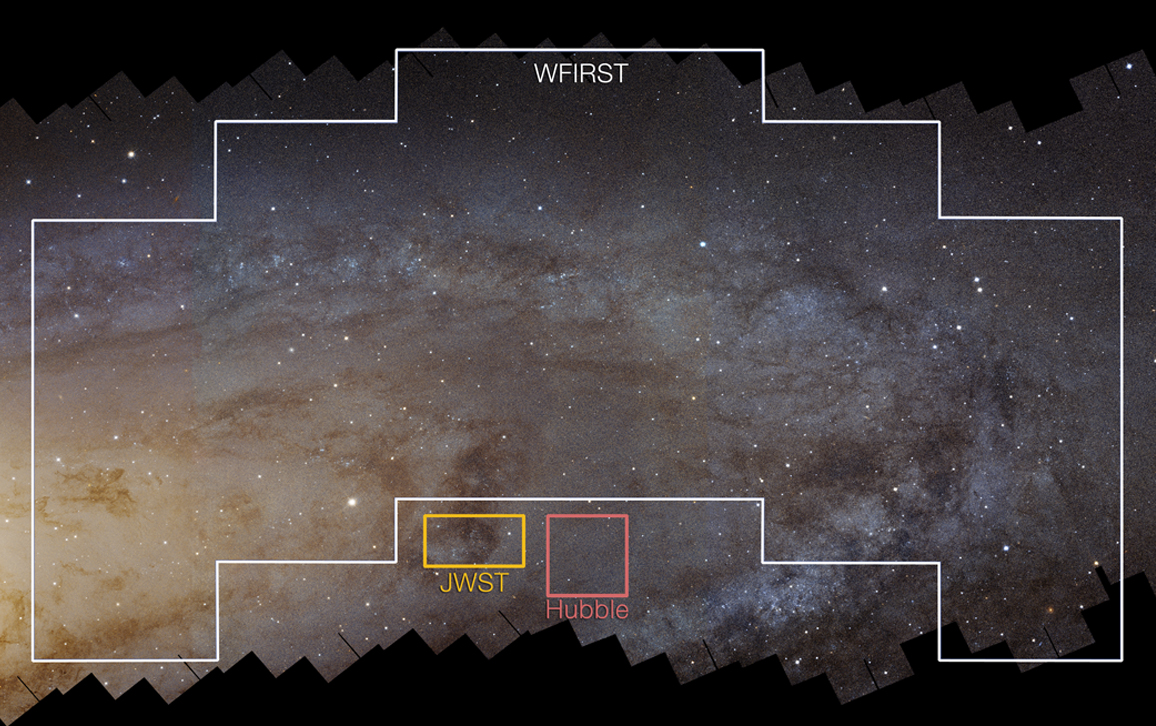Mapping the Distant Universe
By Brant Robertson
The Wide Field Infrared Survey Telescope looks broadly and back in time
The Wide Field Infrared Survey Telescope looks broadly and back in time

When peering into the distant universe, astronomers often have to choose between observing a wide swath of sky with many galaxies or focusing on a small sliver of fewer galaxies from farther back in cosmic time. A space telescope slated to launch in the mid-2020s will not force that choice upon astronomers: It promises them the ability to survey areas of sky hundreds of times wider than those afforded by current telescopes, while allowing them to see back in time to the early universe. The space observatory is called WFIRST, the Wide Field Infrared Survey Telescope, and its mission is to find and characterize planets orbiting stars beyond the Sun, to map the formation and evolution of more than 10 million galaxies over the past 13 billion years, and to probe the mysterious dark energy accelerating the expansion of the universe.

Image of galaxy courtesy of NASA
With its broad mission and ability to see far and wide, WFIRST will collect vast amounts of data—a terabyte will be sent back to Earth each day. NASA plans to make this treasure trove of data immediately available to the public, democratizing astronomers’ access to observations and the way they make discoveries. Astronomers will also have the opportunity to create custom-designed observations to answer scientific questions that arise in the 2020s that we cannot anticipate today.
The concept for the mission started to take shape in 2012 when the U.S. government provided NASA with portions of a telescope that could explore swaths of sky more than 1,000 times larger than the Moon. Building on that equipment, engineers designed detectors for WFIRST that have the same image precision and power as the Hubble Space Telescope, and the same-sized 2.4-meter primary mirror, but have the ability to see 100 times more sky area.
WFIRST will also have a much wider field of view than Hubble’s successor JWST, the James Webb Space Telescope—a near- and mid-infrared space telescope with a 6.5-meter primary mirror set to launch in 2021. Despite the differences in field of view, the telescopes complement each other. WFIRST has the breadth of view to spot transient events—such as explosions from the deaths of massive stars in the very distant universe—as they happen. JWST could then zoom in and show even greater detail of the dying stars or other transient events. If WFIRST gets funding for 2019, it might even be up in space at the same time as JWST, giving astronomers an unprecedented ability to study exploding stars and early galaxies.
WFIRST will also offer an unparalleled opportunity to discover exoplanets using a technique called gravitational microlensing. That’s when one star in the sky passes in front of another and acts as a lens, magnifying the background star’s light. If the foreground star has a planetary system, the planets also act as lenses, magnifying the light of the background star even more. Such observations could reveal how common planets similar in size to Earth are in the Milky Way.
The telescope will also give astronomers the ability to quantify the rate at which individual galaxies form stars, and to probe the properties of the intergalactic gas between galaxies in the very early universe. These observations are important for understanding the fundamental physics that give rise to large-scale structures in the universe. Because the telescope is also able to study exploding stars and measure shapes and distances to early galaxies, those observations will give clues to the evolution of dark energy over cosmic time.
Click "American Scientist" to access home page
American Scientist Comments and Discussion
To discuss our articles or comment on them, please share them and tag American Scientist on social media platforms. Here are links to our profiles on Twitter, Facebook, and LinkedIn.
If we re-share your post, we will moderate comments/discussion following our comments policy.